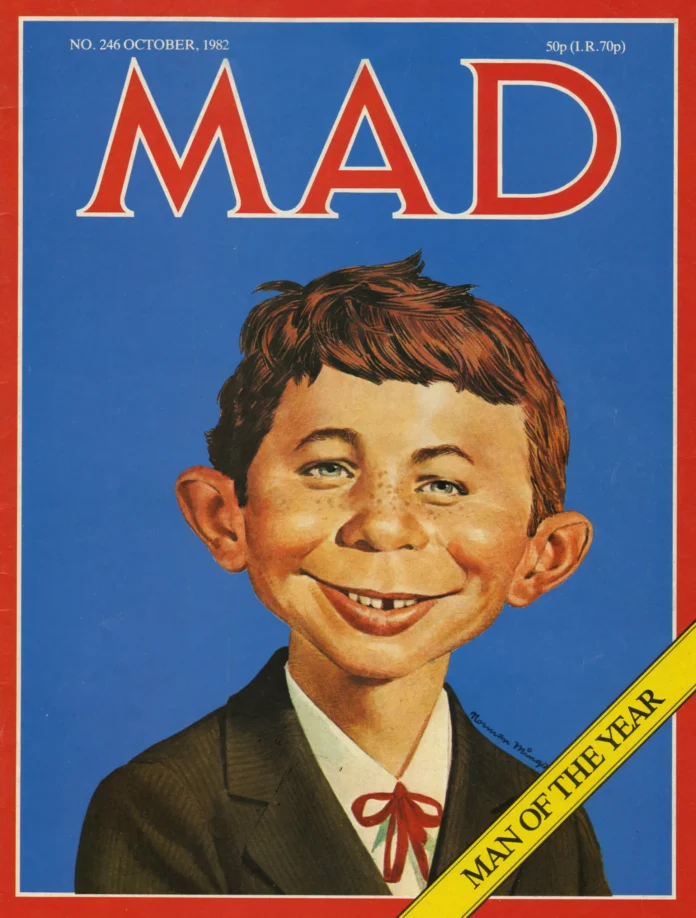SHOWBIZZTODAY – In the hallowed halls of Hollywood fame, where the stars of history’s most celebrated actors, directors, and composers are enshrined, there remains one glaring, gap-toothed omission. We speak, of course, of Alfred E. Neuman, the eternal adolescent and mascot of MAD Magazine. For decades, this red-haired rascal has observed the follies of Tinseltown with a serene grin and a timeless motto: “What, me worry?” It’s high time we gave him a permanent address on the Walk of Fame, and frankly, the reasons are so obvious it’s a wonder we haven’t already.
A Star is Spawned: The Neuman Origin Story
Unlike your typical Hollywood ingénue, Alfred E. Neuman didn’t burst onto the scene from a prestigious acting school. He simply… emerged. His grinning mug is a showbiz legend in its own right, a meme born a century before the internet. His face first appeared in the dusty corners of American pop culture, from painless dentistry ads in the early 1900s (tagline: “It Didn’t Hurt a Bit!”) to political postcards and soda bottle labels .
He was a true showbiz orphan, a public-domain urchin adopted by MAD Magazine in the 1950s. The story goes that editor Harvey Kurtzman spotted the “What, Me Worry?” kid on a postcard and was smitten . He was officially christened Alfred E. Neuman—a name pilfered from a running gag on the Henry Morgan radio show, which itself borrowed it from Hollywood composer Alfred Newman—and his face was forever immortalized by illustrator Norman Mingo on the cover of MAD #30 . His journey from advertising bumpkin to cultural icon is a Hollywood story more compelling than most biopics.
The Unflappable Star: Qualities Worthy of a Star
In a town built on anxiety, Alfred E. Neuman is the zen master we need. While A-listers fret over box office numbers, critics, and their next franchise role, Alfred’s philosophy is refreshingly simple. The world could be literally collapsing around his ears—and on countless MAD covers, it has been, from asteroid impacts to zombie invasions—and his response remains a placid, “What, me worry?” . This is not the look of an idiot, but of a sage. As founding editor Al Feldstein instructed Norman Mingo, he should be “lovable and have an intelligence behind his eyes… someone who can maintain a sense of humor while the world is collapsing around him” . He is the epitome of grace under pressure, a quality every star in Hollywood aspires to but so rarely achieves.
Furthermore, his face is one of the most recognizable in the world, on par with any corporate logo. Feldstein intentionally sought to create a visual mascot for MAD on the same level as “the Jolly Green Giant and the dog barking at the gramophone for RCA” . In this, he succeeded spectacularly. That gap-toothed grin has gazed out from over half a century of magazine covers, making him a more consistent box-office draw than most living actors.
Clearing the (Legal) Red Carpet: A Star is Vindicated
What’s a Hollywood legend without a little legal drama? In the 1960s, MAD was sued by the widow of a cartoonist who claimed her husband had created and copyrighted the “What, Me Worry?” face in 1914 . The case went all the way to the federal appellate court, and MAD triumphed by proving the image was in use long before the 1914 copyright was filed . The Supreme Court upheld the ruling, effectively making Alfred a man of the people—a star born not in a studio, but in the public domain . He earned his fame the hard way, fighting for it in the highest courts in the land. If that doesn’t scream “Hollywood ending,” what does?
The Competition: Or, Who is Parkyakarkus?
To truly appreciate the travesty of Alfred’s absence, one must peruse the current roster of Walk of Fame honorees. The path is paved with stars for figures whose fame has, shall we say, niche appeal today. Consider the entry for Parkyakarkus, a comedian specializing in “Greek dialect comedy” in the 1930s . Or Hoot Gibson, a rodeo champ turned cowboy actor . Or the collective star for The Dead End Kids, a group of young actors known as much for crashing a truck into a soundstage as for their films .
This is not to disparage these pioneers. But it does raise a question: does the grinning, worry-free face that has watched over decades of American satire, and is known to millions, deserve a spot less than Parkyakarkus? The answer, we propose, should be met with a resounding, “What, me worry?”
The Inauguration We Deserve
Imagine the ceremony. The paparazzi flashbulbs pop. The crowd cheers. And instead of a tearful celebrity speech, there is only the quiet, confident grin of Alfred E. Neuman, immortalized in pink terrazzo and brass. Perhaps his star could be placed directly outside a plastic surgeon’s office or a studio executive’s building, as a permanent reminder of the follies he so brilliantly satirized.
The editors at MAD have always been fiercely protective of their mascot. Current artists are instructed to draw him based solidly on the Mingo original, never in profile, and almost never with a word balloon . This careful curation has preserved his character for generations. He is a constant in a changing world, and Hollywood, for all its obsession with the new, desperately needs constants.
Alfred E. Neuman has spent his entire career holding a funhouse mirror up to Hollywood, exposing its vanity, its trends, and its occasional absurdity with a gentle, knowing smirk. He is not just a candidate for the Hall of Fame; he is its unofficial patron saint. It’s time to make it official. Let’s give the kid a star. He’s earned it, and we have no doubt what his response would be.

